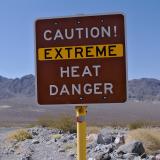Drought Assessment in a Changing Climate: Priority Actions & Research Needs
Assessing Drought in a Changing Climate
In a changing climate, the intensity, duration, and frequency of droughts may change. This poses new challenges for drought assessment. Current methods for assessing drought conditions do not consistently and deliberately consider drought in the context of climate change, thereby unintentionally promoting drought response strategies that are limited in building long-term resilience in a changing climate.
On February 28–March 1, 2023, NOAA’s National Integrated Drought Information System (NIDIS) and the USDA Climate Hubs co-hosted a Technical Workshop on Drought Assessment in a Changing Climate. During the meeting, more than 100 subject matter experts identified priority actions and outstanding research questions aimed to address this issue.
The outcomes of the meeting directly informed the development of a NOAA Technical Memorandum, Drought Assessment in a Changing Climate: Priority Actions and Research Needs, which highlights priority actions and research questions to improve drought assessment across several focus areas.
In August 2024, NIDIS announced the Coping with Drought: Drought Assessment in a Changing Climate competition, which targets a key focus area identified in the Technical Memorandum: Improving Drought Indicator Performance. This competition will provide up to $4 million in funding for 8 two-year projects focused on improving drought indicator performance to account for non-stationarity with the goal of more accurate drought assessments that support communities in preparing for, mitigating, and responding to drought.

Explore the Report & Related Research
Read the Report
On November 29, 2023, NIDIS and the USDA Climate Hubs released a NOAA Technical Memorandum, Drought Assessment in a Changing Climate: Priority Actions & Research Needs, which highlights priority actions and research questions across several research focus areas to advance the knowledge and understanding of drought assessment into the future.

Focus Areas for Improving Drought Assessments
The Drought Assessment in a Changing Climate report summarizes priority actions and research questions that the research and practitioner community identified to improve drought assessment. The intent is not to provide authoritative guidance or design specifications for specific research or programmatic endeavors, but to illuminate current and future needs to best account for a changing climate in our drought assessment practices. These research questions and priority actions are broken down into fifteen cross-cutting research focus areas.
View a short summary of each focus area, as well as select research initiatives working to address the gaps identified in the report. If you’re interested in a particular focus area, read the full report for a more comprehensive description with a diverse set of actions and research questions for each focus area.
Is your research supporting one or more of these focus areas? Please contact Britt Parker (britt.parker@noaa.gov) to tell us about it!
Learning with Indigenous Communities

Future research should embrace multidisciplinary approaches, incorporating indigenous research methods, embracing different worldviews, and hybrid knowledge frameworks to co-create new knowledge, while also considering data sovereignty and reciprocity.
Download this section of the report for more information, including research questions and priority actions.
Explore select NIDIS and partner research that supports learning with indigenous communities.
- Workshop for Building Drought Resilience in a Changing Climate with Upper Columbia and Missouri Basin Tribes: In October 2023, NIDIS and the Confederated Salish and Kootenai Tribes co-hosted this workshop, which provided a forum for Tribal Nations and Tribal Colleges and Universities in the region to share successes, challenges, opportunities, and ideas for managing current and future drought in the context of a changing climate.
Benchmarking Our Understanding and Assessment of Drought in a Changing Climate

Building accurate and useful drought assessments could greatly benefit from a National Academies or similar study on our current understanding of drought and climate change, as a foundation for future research. Knowledge exchange across hazards, sectors, and with the global drought community could accelerate learning in how to address non-stationarity across multiple hazards.
Download this section of the report for more information, including research questions and priority actions.
Evaluating Data Relevance, Fidelity, Integration, Metadata, and New Technologies

Where past droughts may not be analogous to future drought, drought indicators should be consistently evaluated for quality and relevance when characterizing drought in a changing climate. This should include exploring emerging data science capabilities and how they can be used to improve drought assessment.
Download this section of the report for more information, including research questions and priority actions.
Explore select NIDIS and partner research that supports evaluating data relevance, fidelity, integration, metadata, and new technologies.
Determining the Physical Drivers of Drought and How They Are Changing

Weather and climate models must be modernized through continued efforts to better represent land surface processes (e.g., evapotranspiration) and ensure accurate representation of global-scale drivers of drought—even given uncertainty in how these might change in a warming world.
Download this section of the report for more information, including research questions and priority actions.
Explore select NIDIS and partner research that supports determining the physical drivers of drought and how they are changing.
Understanding Drivers of Aridification and Their Interactions with Drought

A unified framework is needed to define, identify, and quantify the drought-to-aridification continuum. This will help delineate the differences between droughts—episodic events that may last multiple months, seasons, years, decades, centuries— and a permanent change toward a drier climate (aridification).
Download this section of the report for more information, including research questions and priority actions.
Explore select NIDIS and partner research that supports understanding the drivers of aridification and their interactions with drought.
Addressing Regional Differences in Non-Stationarity

Climate change manifests differently across space and time and affects regions in unequal ways, and drought assessment should address regional differences. This includes identifying indicators and periods of reference that perform best for the region based on the goal of the assessment. This also recognizes that differences in economic sectors, cultural practices, ecosystems, and habitats create different experiences of drought impacts that need to be accounted for in assessments.
Download this section of the report for more information, including research questions and priority actions.
- Drought Risk Atlas: This tool from the National Drought Mitigation Center allows users to explore historical trends and period of record by location.
Improving Drought Indicator Performance

Drought assessment in a changing climate requires accounting for non-stationarity in drought indicators. In addition, challenges that impact indicator performance must be addressed, including changes in extreme events, snowpack and melt; processes like evapotranspiration and primary productivity due to climate change; as well as work to better understand drought recovery.
Download this section of the report for more information, including research questions and priority actions.
In August 2024, NIDIS announced up to $4 million in funding for 8 two-year projects as part of the Fiscal Year 2025 NIDIS Coping with Drought: Understanding and Assessing Drought in a Changing Climate competition, which seeks projects to advance this focus area, "Improving Drought Indicator Performance." Projects will focus on improving drought indicator performance to account for non-stationarity.
Explore other select NIDIS and partner research that supports improving drought indicator performance:
Using Precipitation Effectiveness More Broadly to Capture Rainfall Variability

Current precipitation-based metrics may show drought improvement when, in reality, precipitation has fallen too quickly and has run off instead of infiltrating the soil. Precipitation metrics that can more accurately portray drought conditions are needed as precipitation variability (e.g., extreme events) increases and patterns (e.g., seasonality) change.
Download this section of the report for more information, including research questions and priority actions.
Explore select NIDIS and partner research that supports using precipitation effectiveness more broadly to capture rainfall variability.
- Update to the National Precipitation Frequency Standard: The NOAA Office of Water Prediction is updating the NOAA Atlas 14 precipitation frequency standard while accounting for climate change and is developing precipitation frequency estimates for the entire U.S. and its territories.
- Precipitation Prediction Grand Challenge Strategy: NOAA's Precipitation Prediction Grand Challenge Initiative aims to provide more accurate, reliable, and timely precipitation forecasts across timescales. Improvements in precipitation forecasting can inform metrics.
Quantifying Water Demand in a Changing Climate

Drought assessments are complicated by shifts, or potential shifts, in water demand from physical processes (e.g., evapotranspiration) and human water use. Improved understanding and monitoring of changes in water availability and shifts in demand across sectors would provide better insight for future water management.
Download this section of the report for more information, including research questions and priority actions.
Evaluating Drought Impacts and How They Are Changing

Climate change not only shifts the physical nature of a drought, but also the ways drought impacts sectors and communities. Climate change may also increase the urgency people have in responding to or adapting to drought. Understanding how human behavior can mitigate or exacerbate how impacts are felt and linking this to drought indicators can inform thresholds for planning and response.
Download this section of the report for more information, including research questions and priority actions.
Explore select NIDIS and partner research that supports evaluating drought impacts and how they are changing.
Assessing Drought in Terms of Risk

Assessing drought risk not only considers the probability or likelihood of an event, but also the harmful impacts of the event to specific individuals, communities, and systems. Drought assessment should acknowledge and account for non-stationarity in both the biophysical and human contexts, identify and quantify the cost of drought across social-ecological systems, and link this information to resource management decisions.
Download this section of the report for more information, including research questions and priority actions.
Assessing Policy through the Lens of Non-Stationarity

The way that drought is assessed and how drought metrics incorporate non-stationarity has policy implications. Policy research needs to examine these implications and how science can inform future policies and programs.
Download this section of the report for more information, including research questions and priority actions.
Explore select NIDIS and partner research that supports assessing policy through the lens of non-stationarity.
Strengthening Planning, Management, and Adaptation

Ultimately, decision-makers need access to appropriate information to inform proactive decision-making based on the best available knowledge and information. The need to link improvements in drought assessment to planning and decision making becomes more relevant, and urgent, given the complexity that non-stationarity brings to this challenge.
Download this section of the report for more information, including research questions and priority actions.
Explore select NIDIS and partner research that supports strengthening planning, management, and adaptation.
Improving Communication and Collaborative Knowledge Exchange

Non-stationarity adds to the complexity of communication challenges and necessitates an increased focus on knowledge exchange. This includes communicating confidence and/or uncertainty in drought assessments in a way that informs decision-making.
Download this section of the report for more information, including research questions and priority actions.
Explore select NIDIS and partner research that supports improving communication and collaborative knowledge exchange.
Web Resources
Explore the Report: Drought Assessment in a Changing Climate
Drought Assessment in a Changing Climate: Priority Actions and Research Needs (Full Report)
Focus Areas for Future Investment:
- Learning with Indigenous Communities
- Benchmarking Our Understanding and Assessment of Drought in a Changing Climate
- Evaluating Data Relevance, Fidelity, Integration, Metadata, and New Technologies
- Determining the Physical Drivers of Drought and How They Are Changing
- Understanding Drivers of Aridification and Their Interactions with Drought
- Addressing Regional Differences in Non-stationarity
- Improving Drought Indicator Performance
- Using Precipitation Effectiveness More Broadly to Capture Rainfall Variability
- Quantifying Water Demand in a Changing Climate
- Evaluating Drought Impacts and How They Are Changing
- Assessing Drought in Terms of Risk
- Assessing Policy through the Lens of Non-stationarity
- Strengthening Planning, Management, and Adaptation
- Improving Communication and Collaborative Knowledge Exchange
Drought.gov News Story: New Report on Drought Assessment in a Changing Climate
Drought Assessment in a Changing Climate: Workshop Materials
Drought Assessment in a Changing Climate Technical Workshop: View the agenda and desired outcomes for the workshop, which was held on February 28–March 1, 2023.
Presentation Recordings: Drought Assessment in a Changing Climate Pre-Workshop Webinar: View video recordings of presentations from the pre-workshop webinar, which was held on February 10, 2023.
Other Climate & Drought Resources
Prioritization of Research on Drought Assessment in a Changing Climate
Synthesis Paper in Earth's Future
Drought Assessment in a Changing Climate: A Review of Climate Normals for Drought Indices
Literature Review in the Journal of Applied and Service Climatology
Fifth National Climate Assessment
U.S. Global Change Research Program
U.S. Climate Resilience Toolkit
NOAA's Climate Program Office, U.S. Global Change Research Program
Climate Mapping for Resilience and Adaptation (CMRA)
U.S. Global Change Research Program
2022 State Climate Summaries
NOAA's National Centers for Environmental Information
Research Spotlight: Climate-Driven Megadrought
NOAA's National Integrated Drought Information System
Climate Toolbox: Climate Mapper
University of California – Merced


